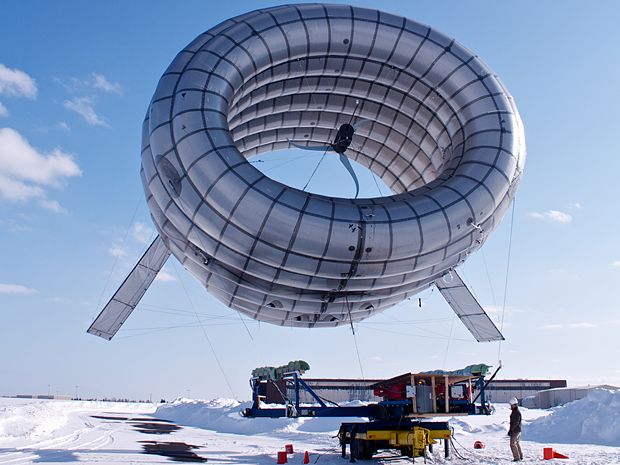The title for world’s largest wind turbine is constantly up for grabs
as manufacturers build higher and bigger to capture more energy from
the passing air. One turbine in Alaska, however, will now spin high above the rest.
Altaeros Energies will launch its high-altitude floating wind turbine
south of Fairbanks to bring more affordable power to a remote community.
Ben Glass, CEO of Altaeros told The New York Times that the company
expects to provide power at about $0.18 per kilowatt-hour, about half
the price of off-grid electricity in Alaska.
Unlike its earth-bound brethren, the airborne turbine is not intended
to supply power for large electric grids. Instead, its sweet spot is
serving far-flung villages, military bases, mines, or disaster zones.
Various researchers have been developing floating wind turbines for
years, but the 18-month project in Alaska will be the first longer-term,
commercial project to test the technology, according to Altaeros. Altaeros’ Buoyant Airborne Turbine (BAT) is an inflatable,
helium-filled ring with a wind turbine suspended inside. It will float
at a height of 300 meters, where winds tend to be far stronger than they
are on the ground. The altitude of the BAT is about double the hub
height of the world’s largest wind turbine.
The BAT has a power capacity of 30 kilowatts and will create enough
energy to power about 12 homes, the company says. But that’s just the
beginning. It can also lift communications equipment such as cellular
transceivers or meteorological devices and other sensing equipment.
Altaeros said additional equipment does not affect the energy
performance of the turbine.
The technology can be deployed in under 24 hours, because it does not
require cranes or underground foundations. Instead it uses
high-strength tethers, which hold the BAT steady and allow the
electricity to be sent back to the ground. A power station on the ground
controls the winches that hold the tethers and pulls in the power from
the turbine before sending it on to a grid connection. Altaeros has
tested its BAT prototype in 70 kilometer-per-hour winds, but because it
uses the same technology as other industrial blimps that are rated to
withstand hurricane-level winds, it might be able to withstand stronger
gusts.'

Altaeros says there is a US $17-billion remote power and microgrid
market that could benefit from the technology. Many off-grid sites,
including small islands, mining sites or military bases, rely on
expensive diesel generators to provide some or all of their power needs.
There are many projects that are trying to develop integrated solutions
to tackle this market, particularly microgrids that integrate some type
renewable energy. The Boston-based startup is hardly alone in flying power stations,
either. Last year, Google X purchased Makani Power that makes airborne
wind turbines that resemble small airplanes. At the time, Google told
TechCrunch that the appeal of Makani was that “They’ve turned a
technology that today involves hundreds of tons of steel and precious
open space into a problem that can be solved with really intelligent
software.” Other airborne wind companies include WindLift, SkySails, Sky
Windpower, and NTS.
The $1.3 million project in Alaska is financed by Alaska Energy
Authority’s Emerging Energy Technology Fund and RNT Associates
International, which is owned by the former chairman of the Indian
conglomerate Tata Group, which includes Tata Power, India’s largest
integrated power company.
No comments:
Post a Comment